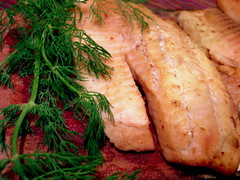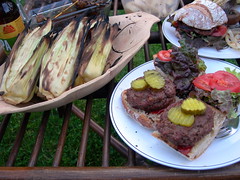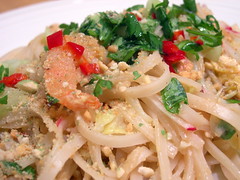
During a visit to NYC, I met up with my friend Pete for lunch at Isabella's. We grabbed a table on the sidewalk and settled in to a three course fixed-price meal - a bargain for about $20 which in my case included soft shell crabs as the main dish and tiramisu for desert. The starter I chose was a fabulous Watermelon Gazpacho with blackened shrimp. When we got back to sweltering NC in the midst of 100 degree plus weather, I attempted to recreate the dish using a recipe I found. The results were pretty good, all things considered.
What we discovered is that a little gazpacho goes a long way - especially with the amount of olive oil called for in this recipe. It may be a good idea to scale back a little on the oil or plan for a very modest serving. Very tasty, but very rich. I also learned that the smell of poorly sealed watermelon gazpacho tends to permeate the entire refrigerator - causing ice and other stuff to absorb that flavor. You have been warned.
This is the recipe from the Boston Globe co-opted from the Straight Wharf Restaurant -
2 medium cucumbers, peeled, seeded, and diced (about 2 cups)
1/2 cup olive oil, plus 2 tablespoons for garnish
1/4 cup sherry vinegar, or to taste
Salt and pepper, to taste
1 tablespoon sugar, or more to taste
1 bunch scallions, thinly sliced
1/4 cup chopped fresh cilantro
2 jalapeno peppers, seeded and finely chopped
1/4 cup lime juice
1. Peel tomatoes with a serrated peeler or cut a small X in the bottom of each, blanch in boiling water for about 30 seconds, then transfer to ice water and slip off the skins. Discard seeds and chop the flesh. You should have about 4 cups.
2. Reserve 2 tablespoons tomato, 2 tablespoons watermelon, and 2 tablespoons cucumber for garnish.
3. In a food processor, combine the remaining tomato, watermelon, and cucumber. Blend until smooth. Add 1/2 cup of olive oil, sherry vinegar, salt, pepper, and sugar. Pulse to combine.
4. Transfer the mixture to a large mixing bowl. Stir in the scallions, cilantro, jalapeno peppers, and lime juice. Taste for seasoning and add more salt or vinegar, if you like. Cover and refrigerate for several hours or until chilled.
5. Ladle the gazpacho into 8 bowls. Garnish each with remaining chopped tomatoes, watermelon, cucumbers, and a drizzle of olive oil.



